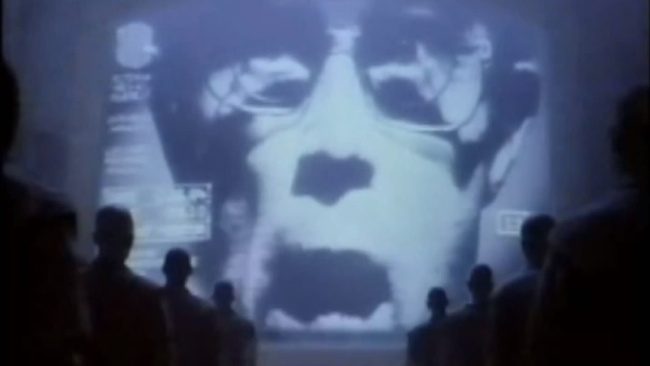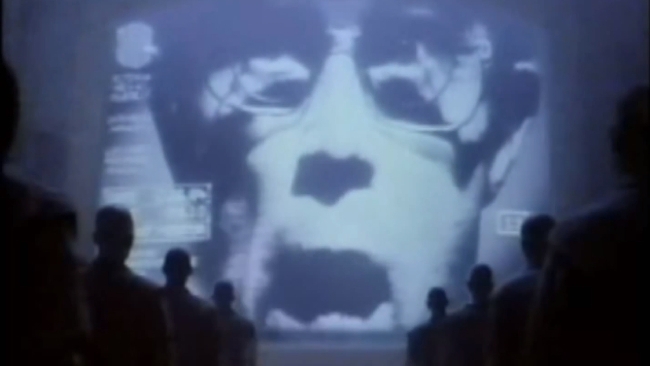
 Apple Superbowl Commercial
Apple Superbowl Commercial
Some 30 years after the Macintosh debuted in a jaw dropping commercial that still sets the standards for such things, the cult of Apple shows no sign of diminishing. What tends to be forgotten though is that Steve Jobs was ousted from his own company soon after and that Apple very nearly didn't make it into the 21st century. Andy Stout charts the company's wilderness years
Super Bowl Sunday 1984, and Apple had chosen a break at the end of the third quarter to run an advert for its new computer. As gestures go, it was a brash one. Even then ad time during the Super Bowl cost as much as $1 million per minute, and the production costs of the Orwellian saga directed by Ridley Scott that the Cupertino-based company chose to highlight its new machine weren't far off.
On the —admittedly slim — off chance that you haven't seen it, it's a masterpiece of its kind. Slack-jawed drones in a drab monochrome world stare at a screen while a ranting dictator harangues the crowd. Suddenly, a woman carefully graded to be the only splash of colour in the place bursts into the auditorium pursued by security police. She runs into the centre of the auditorium and lets fly with an Olympic hammer which flies at the screen and shatters it into a thousand fragments. Then comes the voice-over: "On January 24, Apple Computer will introduce Macintosh and you'll see why 1984 won't be like 1984."
Astonishing
The reaction was astonishing, the commercial quickly becoming a news item in its own right and deemed by many media commentators to be revolutionary. And what of the computer it was talking about? Three decades on it seems woefully under-specced, matching a 8MHz Motorola chip with 128K of RAM, 64K of ROM, a 3.5in disk drive and a 9in black and white monitor. What's more a mere three programs were available for it at launch, MacWrite, MacPaint, and a spreadsheet application from Microsoft. But arrayed against all those disadvantages — it wasn’t even compatible with its immediate predecessor, Lisa, nor the company’s best-selling Apple II — was the fact that its WYSIWYG GUI was the most advanced seen out of a research lab at that point, and that was revolutionary all in itself.
In the long-term, it saved the company; in the short term it almost ruined it. The computer had been developed at Apple in parallel with its Lisa forbear in an atmosphere of bitter internal rivalry and creeping paranoia, all of which became far more relevant to the company's increasingly unanchored internal logic than anything involving market research or an understanding of what the consumer really wanted at the time. Yes, it shipped with a mouse; yes, the way that people could interact with it was revolutionary, but no product can exist in total isolation and it was up against the incumbent IBM PC in the marketplace. That had a bigger screen, colour, was expandable (the Mac was very much a sealed system in contrast to the resolutely homebrew, expandable and, more importantly, successful Apple II), and crucially the PC also had thousands of programs sitting on the shelves ready and waiting for it.
Apple II
The Apple II had been such a long-standing success for the company partly because it had run a spreadsheet program called VisiCalc. Indeed, about 20% of all Apple IIs — that's one million machines — had been bought specifically to run that program. Software sells computers, and that seems to have been a lesson that Apple forgot.
What the history books will eventually make of Steven Paul Jobs is unknowable, but the perspective of those that lived during his lifetime reveals a complex and contested figure: part messianic leader, part wilful egotist. It is easy for a business press eager to create heroes and villains to over egg the role that individuals play in a company, but Steve Jobs really did seem to become indivisible with the company that he co-founded. And when he faltered, it faltered.
"Steve did his market research by looking in the mirror every morning," a colleague once said, and what Jobs saw certainly wasn't the average computer buyer looking back at him. Little over a year after launch Macintosh revenues were approximately 10% of forecasts, the company was riven by internecine warfare, and on May 28, 1985 the Apple board voted Jobs out of the company. He kept one single share, purportedly so that he could still receive the company's annual reports.
Pixar
While Jobs headed off to run a few little ventures such as Pixar and NeXT, Apple began its decade-long period of tribulation. It wasn't an out of control downhill run — the introduction of the PowerBook in 1991 and the agreement between Apple, IBM and Motorola that bequeathed the PowerPC chips and thus Power Macs to the world in 1994 were both significant highlights — but the overall trend in an increasingly competitive and cutthroat industry was downwards.
Once upon a time the company commanded a 20% marketshare. By 1993 that was down to 8%. New machines failed to set the world on fire, often being simply slightly confusing iterations of what had gone before, were over-priced compared to their Windows-powered counterparts, still languished behind in the software stakes (early Mac users could be turned glum at the mere mention of the words 'computer' and 'game' in the same sentence) and the proprietary nature that was the company's legacy kept it locked into its own development cycles rather than allowing it to piggyback on an industry-wide surge powered by the continued application of Moore's Law. And the whole Cult of Mac paradigm that had hung on Jobs' every word struggled to get enthused by a succession of CEOs that, while they might have eventually turned the company round — step forward Gil Amelio — were, essentially, suits.
Sun was going to buy it!
A decade after the Mac's launch the company was quietly for sale. Sun was interested and by all reports a deal was hours away from being inked in 1996 before it was leaked to the press, Apple's latest financials were revealed, and the erstwhile suitor pulled out of the deal. That's not to say that other deals weren't quietly done along the way though. Following on from the mould-breaking PowerPC agreement, the company announced plans to license its OS to third parties and the first machines made by Power Computing shipped in May 1995 running the company's then state-of-the-art System 7 software and ROMs from the Power Mac architecture. Initially this 'expanded markets' approach was to have a narrow focus on sectors and territories where Apple was under-represented, but this swiftly got expanded once the Apple board thought more carefully about the license fees and royalties, the latter pegged at $50 per machine sold.
Power Computing sold six figure numbers of their clone machines and there was even a console, the ill-fated Pippin multimedia platform that was chiefly licensed by Bandai, which can be usefully characterised for historical purposes as over-priced and under-marketed.
Collapsing
Meanwhile it has to be said that despite things collapsing all around it, the core business' penetration of certain markets was astonishing. Aggressive discounting via the Apple Education Foundation made it a hit in the US education space with something approaching a 60% market share, and, in concert with Quark Xpress, it was verging on being dominant in the field of desktop publishing. But the chances were that unless you worked in the creative industries in the mid 90s, you didn't really come across the machines. Big business on the whole kept all things Apple at arm’s length with the result that still the debts mounted and the revenues fell. These were down to $11bn in 1995 and would eventually bottom out in 1998/9 at around the $6bn mark (in stark contrast to the iPhone driven era and $170bn in revenue for 2013).
Once he was made CEO, Gill Amelio slowly began to turn the ship around. There were inventory write downs, lay-offs and restructuring. It was Amelio that started the process of winnowing out the multiple mis-firing development projects that were competing for attention and resources within the company, and crucially looked at the work on the next gen OS systems — then codenamed Copland and Gershwin — and realised they were going nowhere. The solution, he was advised, was to buy in technology.
This turned out to be Jobs' route back into the company. With Bill Gates hovering in the background insisting that Windows NT could be converted into a new Apple OS and offering to put hundreds of people on the project to expedite it, and the idea of licensing Sun software gaining increasing traction too, Amelio and his CTO, Ellen Hancock, eventually decided on a shoot out between BeOS and the Jobs' owned NeXT, which NeXT convincingly won. Amelio designated Jobs, who pocketed 1.5m Apple shares as part of the deal, as 'special advisor'.
That was December 10, 1996. By July 9, 1997, with revenues still on the slide, Amelio had been ousted and Jobs had stepped in as interim CEO.
Mac clones were axed
The new initiatives then came thick and fast, Jobs changing some things within the company and accelerating others (while making sure he took the credit in many cases). 70% of new products in development were axed, the Mac clones were axed (which is partly why the revenues flat-lined in the following two years - market share tumbled even further), stock options for staff were restructured and a bonus scheme put in place to incentivise the residents of Infinite Loop, a deal with Microsoft was struck for its all-conquering Office to appear on the platform (this was roundly booed at the MacWorld where it was announced), and — and this was crucial — Jobs took notice of the internet and jumped on the internal development program started under Amelio and on the verge of completion to market a low-cost consumer computer to navigate it.
As Amelio himself says "[Steve] gave it the name iMac and took all of the credit."
Jonathan Ive's teardrop-shaped design
You only have to read Douglas Coupland's Microserfs, published in the mid 90s, to realise how much the coming of the internet blindsided an industry that thought that CD-ROM was not so much the future as the immediate be all and end all. And you only have to look at the machines of that era to see how completely different the original G3 iMac with its Jonathan Ive teardrop-shaped design truly was. It was back to the glory days of the original Mac again and the idea of a computer as toaster; a consumer device that you plugged into a socket and simply started using. And an eye-catching toaster at that.
In a little over a year the company sold two million of them. The wilderness years were over.
Tags: Business


Comments